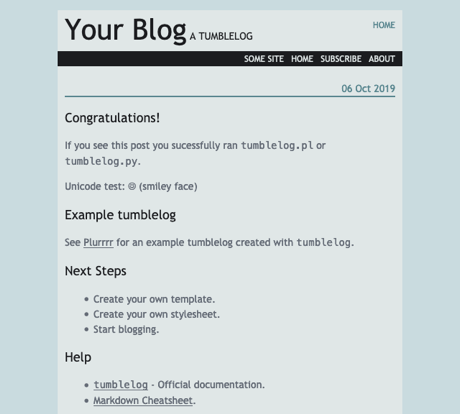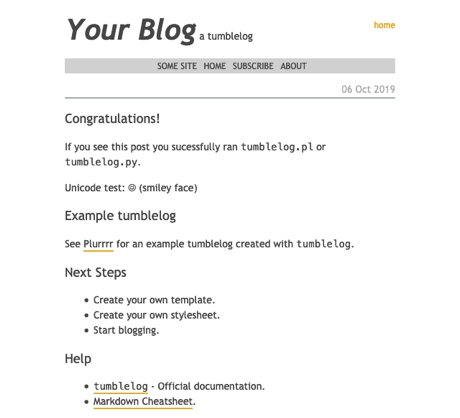Documentation for tumblelog is coming
Some preliminary documentation for tumblelog has been written:
Some preliminary documentation for tumblelog has been written:
I am in favor of this change, because it reflects an ancient wisdom:
“No one sews a patch of unshrunk cloth on an old garment, for the patch will pull away from the garment, making the tear worse. Neither do people pour new wine into old wineskins. If they do, the skins will burst; the wine will run out and the wineskins will be ruined. No, they pour new wine into new wineskins, and both are preserved.”
Source: Path to raku a comment by TimToady aka Larry Wall.
In the evening I wrote more documentation for tumblelog:
The tips in this little document are geared towards Emacs power-users. You should be familiar with the basics of launching and editing with Emacs, and you should already know the essentials of copying stuff into your .emacs file, and debugging things (or finding a friendly Emacs Wizard) when something goes wrong.
Source: 10 Specific Ways to Improve Your Productivity With Emacs, and article by Steve Yegge.
Go can be used to program in a functional style, previously I’ve written about how we can use this to implement Continuation Passing Style programming. As such, it is possible to implement currying in Go as well. Before we take a look at how we can implement this in Go, let’s take a practical look at what function currying actually is, and why we want this.
Source: Function Currying in Go, an article by Dylan Meeus.
Read Hacker News in Emacs thanks to A Gnus backend for Hacker News by Dick Mao.
Via Hacker News I found this handy
tool that converts curl commands to Python, Ansible URI, Node.js, R,
PHP, Strest, Go, Dart, JSON, Rust. Give it a spin: Convert curl
syntax.
You might not be aware that SSH is a magical tool with many different uses. Using it, you can copy files between systems without logging into them, as if by magic.
Source: A little SSH file copy magic at the command line, an article by Ken Hess of Red Hat.
Sadly, the article uses RSA 2048 for generating a key pair; don't, see my SSH Public Key Authentication How To.
Sometimes you might want to import a remote postgres database into your local database. You could use some intermediate files, but there is a much nicer way to do it:
Source: Dump Postgres databases through SSH.
Finding the right code editor for Python development can be tricky. Many developers explore numerous editors as they grow and learn. To choose the right code editor, you have to start by knowing which features are important to you. Then, you can try to find editors that have those features. One of the most feature-rich editors available is Emacs.
Source: Emacs: The Best Python Editor?, a nice article by Jon Fincher; recommended.
Timsort is a sorting algorithm that is efficient for real-world data and not created in an academic laboratory. Tim Peters created Timsort for the Python programming language in 2001. Timsort first analyses the list it is trying to sort and then chooses an approach based on the analysis of the list.
Since the algorithm has been invented it has been used as the default sorting algorithm in Python, Java, the Android Platform, and in GNU Octave.
Timsort’s big O notation is O(n log n). To learn about Big O notation, read this.
Source: Timsort — the fastest sorting algorithm you’ve never heard of, an article by Brandon Skerritt.
Today I learned that there is a CSS media query to detect if your device is running in dark mode:
@media
(prefers-color-scheme: dark) {
// your CSS rules go here
}
Source: Dark mode in a website with CSS.
See also: Using media queries.
In the evening I finished a series of 5 blog posts about the RSS feed
I added to tumblelog and the issues I encountered. The posts are:
In the evening I finished a style for tumblelog that I had started
on the previous day: Wednesday.

tumblelog style Wednesday in action.
This style shows some tweaking in the header of the blog using
position: relative.
What makes an expert software designer? The typical answer — experience and innate ability — is less than satisfying. While it carries elements of truth, it offers little from which we can learn and generalize. Experts clearly do not just approach their work randomly. Quite the contrary, they have specific habits, learned practices, and observed principles that they employ deliberately during their design work.
Source: Eight Habits of Expert Software Designers: An Illustrated Guide, an article by Marian Petre & André van der Hoek.
In the evening I made another style for tumblelog, based on the style
October, called Tuesday.

tumblelog style Tuesday in action.
In the evening I finished a style for tumblelog that I had started
on in the afternoon: Steel.

tumblelog style Steel in action.
In the late afternoon I finished another new style for tumblelog:
Ice.

tumblelog style Ice in action.
In the early evening I finished another style for tumblelog: Pages.

tumblelog style Pages in action.
There are now 9 different styles to choose from!
One more new style for tumblelog: Vector. Now there are 10 styles.

tumblelog style Vector in action.